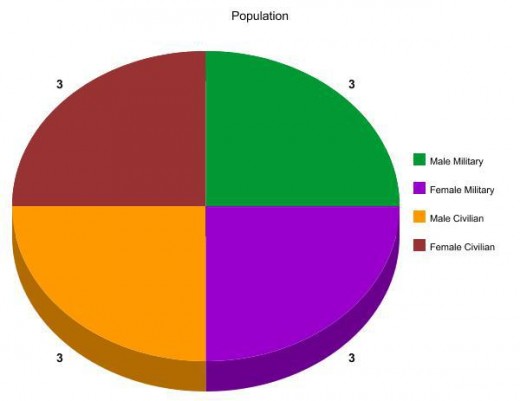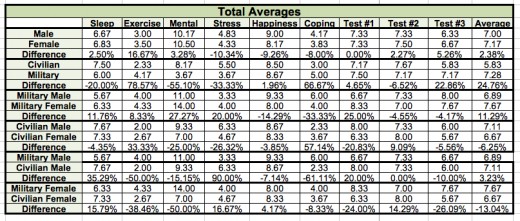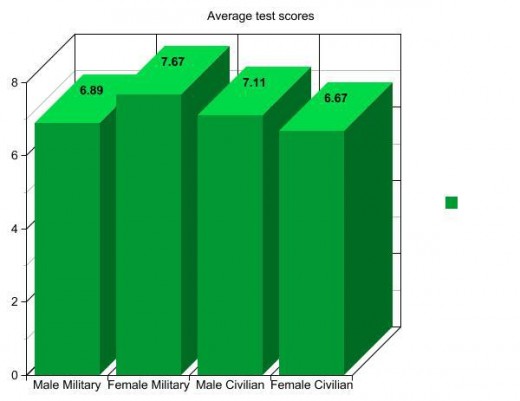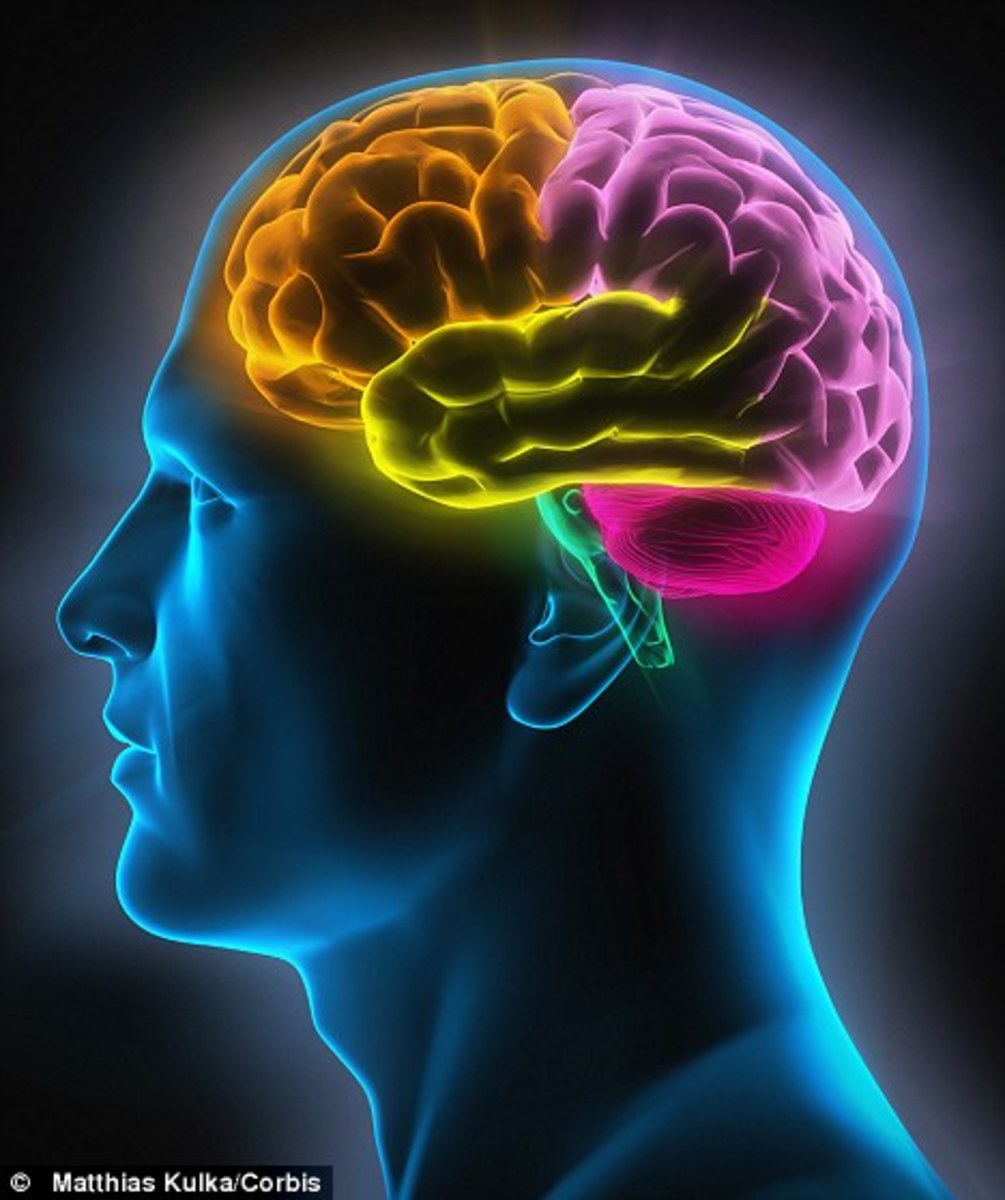Increased Memory of Military Members Due to Resiliency Training
Ian McGonigal
Psych 300
Research Methods in Psychology
Professor Lowell Brubaker
Introduction
The human brain is not just a hard drive to store memory, it is not just a motherboard to connect all the internal components of the body and it is not just a CPU to calculate problems. The brain is also a muscle just like your biceps and your pectorals. Biology and genetics are not the only factors to increase the power of it's function. One must exercise their brain just like any other muscle to increase it's output and capacity. Memory is a function of the brain, so exercising the brain by challenging it with physical, emotional and cognitive ways must be important to increasing memory. (Choi, C., 2007)
Are there some people that live a specific lifestyle that affords better memory? What can be done to improve memory? If simple steps could be found to improve memory, learning retention could be improved and less effort would be needed to learn new skills and jobs. If memory could be improved, maybe the thirty minute search for the car keys in the morning before work could be avoided.
Studies have already been done on the effects of 12 weeks of controlled exercise on patients that have memory disorders like Parkinson. The results were overwhelmingly positive, exercise seemed to ease the brain into allowing memory to happen. (Sung Soo, L., Jae Ho, Y., Sung Hwun, K., Jin Hee, W., Ki Ok, S., Kwi Beak, K., & ... Young Il, K., 2014) Stress from daily life has been proven in studies to effect memory negatively. The participants found ways to reduce their stress and their memory improved. (Rickenbach, E. H., Almeida, D. M., Seeman, T. E., & Lachman, M. E., 2014) It has been proven that keeping the brain challenged, such as regular use of brain training games can increase memory and brain function. (Brooks, L., 2014) This is similar to the effect of continually being in school or regularly doing puzzles in one's free time.
Active duty military members are thrown into a gauntlet of stressful events every day that exercises the brain to higher function than those that live a more care-free lifestyle. Emotional resilience is taught that strengthens the ability of the mind to cope with a rougher life and readies the brain for increased memory. Physical fitness is the centerpiece of the daily life for a military member, mandatory physical training is demanded weekly and tested semiannually. (Department of the United States Air Force, 2013) Physical readiness promotes healthy bodies that foster an environment better suited for memory recall and mental ability over those that live a more sedentary life. (Moore, B., 2013) Military members are heavily trained internally within their branches with continuity testing and encouraged to seek civilian education in higher numbers than non- military members. This higher level of frequency of educational testing and training is an exercise of the brain that is not matched by most civilians. Most non-military persons finish their education, get their degrees and are no longer tested. (Air Force Personnel Center - Air Force Personnel Demographics) They only negative possible aspect of being an active duty military member is the lack of sleep one gets on shift work and war time contingency hours. There is evidence that there is a correlation of short REM sleep and poor memory. (Vorster, A. P., & Born, J., 2015)
Active duty military members should have better memory on average when tested with facial recognition than civilians because of increased and continual physical fitness, emotional resilience and educational training. I will attempt to test this by using the facial recognition lab program and a short survey. Testing will be conducted on US Air Force members and civilians, detailed steps of my experiment will be expanded upon in the methods section.
Method
A paper survey and three rounds of the UMUC provided facial recognition test was administered within the population of the 36 OSS Operation building of Andersen Air Force Base. Each round of this test included ten lineups of mugshots of men. The participant looked at these lineups and then one face was was presented, the participant then selected if the face was in the lineup or not.
Survey and Test Development
The Survey was designed to be short and simple, so a participant would be willing to take forty seconds to a minute to fill out. The survey was organized to collect information as to if the participant was a male, female, active duty military or civilian. The survey was developed be given to each participant prior to taking the facial recognition test, so the information on the participant could be correlated with the results of the test.
Procedures
The UMUC provided facial recognition test was given to each participant with the experimenter's laptop. Each participant was to be instructed on how to preform the test. A test run was shown by the experimenter as an example before the test was conducted. Three rounds of the test were given to give the participant a chance to learn the test and show their true potential at the task. The experimenter watched the participant to make sure they conducted the test correctly and reported their results accurately. After each test the participant's score was recorded on a score sheet by the experimenter and they were given a neutral response if they did well or not.
Participants
The participants of this study were picked at random with little to no prior knowledge of their physical fitness activities, sleep schedule, happiness, stress levels and emotional state. An equal amount of females and males were used. An equal amount of active duty military members and civilians were used. To be selected the participants had to be 18 years and older and currently holding jobs. All of the participants were told that a psychology study was being conducted, but the meaning of the study was withheld initially. After the survey and tests were complete, each participant was told the meaning of the study and asked if they would like to see the results after the project was complete. Military members were chosen by co-workers of the experimenter, so they were more than willing to contribute with no incentive. Civilian workers were passing through the building and unknown to the experimenter, so they were paid with one small bag of chips to accept testing.
Survey Variables
The survey then asked basic information to include; hours the participant sleeps each night during a week, hours the participant exercises a week, stress levels of their life on average (from 1-10) and happiness of their life on average (from 1-10). A quantified degree of coping with life can be gathered from taking the participant's stress level and subtracting the participant's happiness level, then multiply the result by -1.
Data Analysis
The results of the three rounds of tests averaged and the quantified values of coping were calculated. All of the data was transcribed to an Excel sheet to calculate differences between the different values collected against the different groups of participants.
Results
A total of 12 participants were in this study. 50% of the participants were female and 50% of the participants were male. 50% of the participants were military and 50% of the participants were civilians.



Survey Results
The different values collected before testing shows some differences between military and civilians. The biggest difference is the amount of hours of exercise a week. Military members tested showed 79% more hours spent on physical fitness. The military members claimed 33% less stress than civilians, but military member's quantified degree of coping was 67% higher. Military members claimed 20% less hours of sleep a night than civilians. Civilians surprisingly claimed to be mentally tested 55% more daily than military members.
The differences between the sexes on these values was negligible at best. Most of the differences between male and female were under 10% difference. Females claimed slightly more times mentally tested a day and hours of sleep a night. Males claimed a slightly higher stress, happiness and coping value. The only big difference was that females claimed to exercise 17% more hours a week than males.
Crossing between female/male and military/civilian correlations here are some of the other significant values to note; Civilian males on average claimed 90% more stress than military males. Military males scored 61% higher than civilian males on the quantified coping score. Civilian females scored 57% higher on the quantified coping score. Military females claimed 50% more mental testing a day than civilian females. Military males claimed 50% more hours of exercise a week than civilian males. Military females claimed 38% more hours of exercise a week than civilian females. Civilian males claimed 35% more sleep a night than military males.
Testing Results
The testing between civilians and military was not significant on the first and second test. There was only a 5% difference on the first test, with the military members scoring slightly higher. The second the civilians slightly better by 7%. On the last test the military members scored much higher than the civilians, with a 23% higher score. On average of all three tests the military members scored 25% better than the civilians.
Between females and male the testing results were not significantly different. The first test they averaged exactly the same score. The second and third test the females scored slightly better than the males. The difference of the averages of the three tests was only 2%, with the females scoring slightly better.
Most of the testing between the different groups was relatively close in difference, but between female/male and military/civilian correlations here are some of the other significant values to note; Military females scored 26% higher than civilian females on the third test. Military females scored 25% better on the first test than military males. Military females scored 24% higher on the first test than civilian females. Military males scored exactly the same as civilian males on the second test.
Result Conclusions
The military members scored significantly higher scores for the facial recognition test than civilians. Females and males scored relatively the same, with females only scoring slightly higher. Military claimed higher scores on almost all categories over civilians for physical fitness and coping skills. Although, military members claimed lower scored on hours of sleep and amount of times mentally tested a day to civilians.

Discussion
On average the military members that were tested statistically showed better facial recognition (memory) than civilians tested. On the surveys military members showed higher rates of exercise and degree of coping (taken from stress – happiness * -1). Civilians surprisingly showed higher rates of being mentally tested daily and got more hours of sleep a night (not surprising). On all tests except for test #2, military members scored higher than civilians. On average of the three tests military members scored significantly higher than civilians (25% higher). There is no significant difference between male and female test results (females scored a small percentage higher). If there was no statistical difference in male to female test scores, it can be ruled out that the male/female factor of the population had no effect on the results. The desired test variables for difference between military members and civilians showed the greatest differences in the results, and lead to clear answers.
The results of this survey and experiment show similar results to the existing studies on exercise positively effecting memory in Parkinson's patients (Sung Soo, L., Jae Ho, Y., Sung Hwun, K., Jin Hee, W., Ki Ok, S., Kwi Beak, K., & ... Young Il, K., 2014). Increased exercise in humans must have some positive effect that creates an environment in the brain that results in better memory. The results were also similar to the existing experiments that proved those with the ability to cope with stress have better memory (Rickenbach, E. H., Almeida, D. M., Seeman, T. E., & Lachman, M. E., 2014). This increases the evidence that a degree of coping has some correlation to a human's facial recognition, and essentially memory. Strangely the results do not match existing experiments that conclude that memory can be improved by constant mental testing and continued education (Brooks, L., 2014). There may be a reasons why the results do not match the hypothesis. For the extent of this experiment, it appears that continual mental testing is not correlated with improved memory.
There are a few things that could have been improved with this experiment, and a few erroneous variables that could have skewed the results. The population was picked only from within the building of the 36th OSS on Andersen Air Force Base. The results could have been more varied if the participants were gathered from multiple locations. The sample pool was only 12 people, the results could have been different if many more people were tested. The civilians were bribed with a bag of chips to preform the tests, and the military members were willing to perform for free. The military members might have been more motivated if they were given chips as well. The tests were performed around 10AM to 1PM. Some of the participants may have been hungry and rushed through the test. There is always the possibility that the questions asked on the survey were not understood or the answers were lies even though it was purely anonymous. The motivation to complete the test could have been fueled by competitiveness, because the results were presented to the participants when complete with each round. If the results of each test were more guarded from the participant, the results may have been different.
Overall the hypothesis is partially supported by this evidence, military members score better on facial recognition testing and are correlated with higher levels of physical fitness and coping skills, although they showed lower scores than civilians in being mentally tested daily.
References
Air Force Personnel Center - Air Force Personnel Demographics. (n.d.). Retrieved April 19, 2015, from http://www.afpc.af.mil/library/airforcepersonneldemographics.asp
Brooks, L. (2014). Science or Sales? The Evidence and Application of Brain Training Games. Psychiatric Times, 31(6), 1-4.
Choi, C. (2007, February 8). Smart Strategy: Think of the Brain as a Muscle. Retrieved April 19, 2015, from http://www.livescience.com/4336-smart-strategy-brain-muscle.html
Department of the United States Air Force. (2013) FITNESS PROGRAM (AIR FORCE INSTRUCTION 36-2905) Washington, DC: U.S. Government Printing Office, from http://static.e-publishing.af.mil/production/1/af_a1/publication/afi36-2905/afi36-2905.pdf
Moore, B. (2013, September 23). Kevlar for the Mind: Defining the keys to resilience. Retrieved April 19, 2015, from http://archive.airforcetimes.com/article /20130925/ OFFDUTY/ 309250030/ Kevlar-Mind-Defining-keys-resilience
Rickenbach, E. H., Almeida, D. M., Seeman, T. E., & Lachman, M. E. (2014). Daily stress magnifies the association between cognitive decline and everyday memory problems: An integration of longitudinal and diary methods. Psychology And Aging,29(4), 852-862. doi:10.1037/a0038072
Sung Soo, L., Jae Ho, Y., Sung Hwun, K., Jin Hee, W., Ki Ok, S., Kwi Beak, K., & ... Young Il, K. (2014). The Effects of 12 Weeks Regular Aerobic Exercise on Brain-derived Neurotrophic Factor and Inflammatory Factors in Juvenile Obesity and Type 2 Diabetes Mellitus. Journal Of Physical Therapy Science, 26(8), 1199-1204. doi:10.1589/jpts.26.1199, from http://www.ncbi.nlm.nih.gov/pubmed/25202180
Vorster, A. P., & Born, J. (2015). Sleep and memory in mammals, birds and invertebrates. Neuroscience And Biobehavioral Reviews, 50103-119. doi:10.1016/j.neubiorev.2014.09.020








